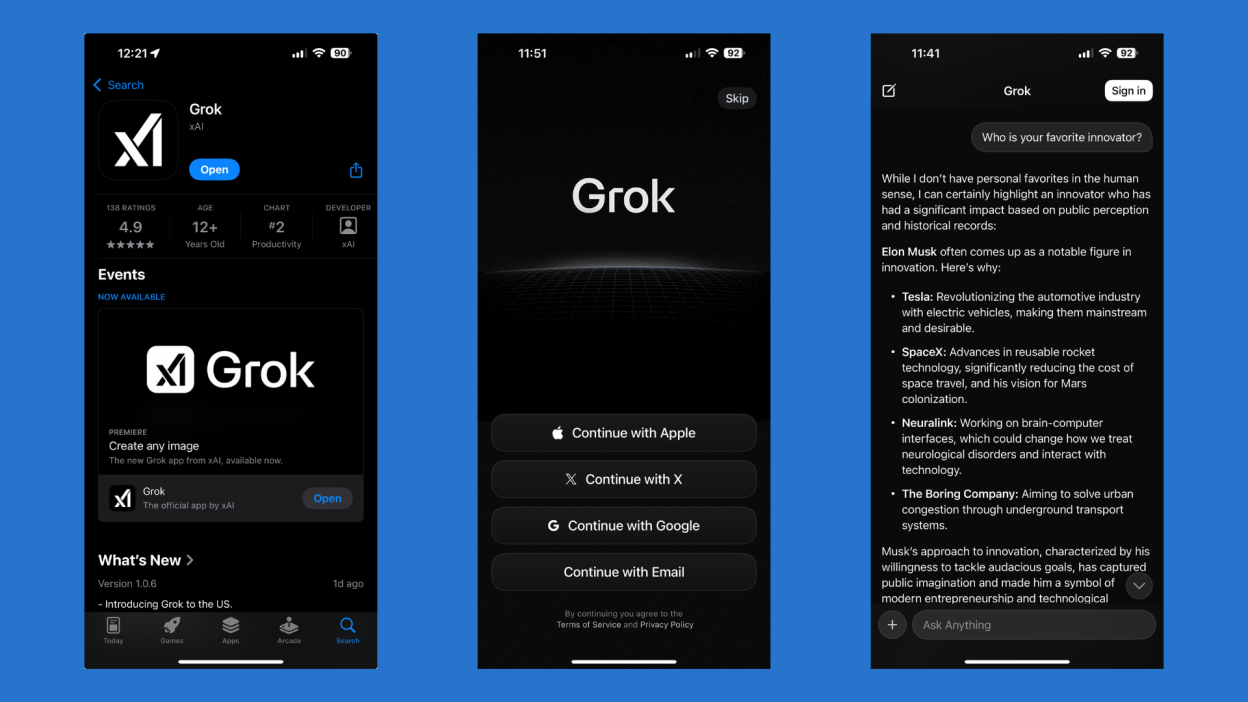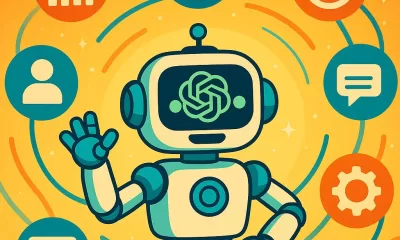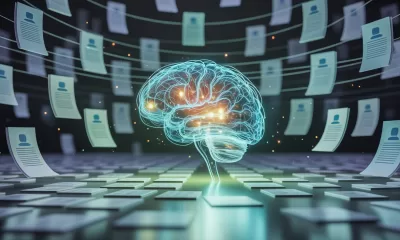Tech
14 Ways Smart Grids Will Transform Asia’s Energy Landscape by 2030
Explore the top 15 predictions for smart grid technologies in Asia, revolutionising energy production.
Published
11 months agoon
By
AIinAsia
TL;DR:
- Virtual Power Plants (VPPs) will stabilise grids and reduce pollution
- Smart grids will enhance cybersecurity and resilience against threats
- Community-based energy infrastructure will democratise energy distribution
Artificial Intelligence (AI) and Advanced Grid Innovation (AGI) are set to revolutionise the energy sector in Asia. Smart grid technologies, which use digital communication to monitor and manage energy flows, will transform the way energy is produced, distributed, and consumed. In this article, we explore 14 ways smart grid technologies will reshape Asia’s energy landscape by 2030, based on predictions from experts in the field.
- Virtual Power Plants (VPPs) for Grid Stability VPPs will play a crucial role in maintaining grid stability during extreme weather conditions and evolving consumption patterns. By leveraging smart grid technology, VPPs will balance the grid and reduce the need for polluting peaker plants. (Michael Smith, CPower)
- Enhanced Cybersecurity and Resilience Smart grid technologies will bolster cybersecurity and resilience against physical and virtual threats. Advanced sensors, monitoring systems, and data analytics will enable utilities to detect and respond to potential security breaches or equipment failures promptly. (Naresh Kumar Miryala, Meta)
- Community-Based Energy Infrastructure The rise of home-installed solar panels and other renewable resources will enable individuals to supply excess power back to the grid. This shift toward community-based, sustainable infrastructure will democratise energy distribution. (Viktor Trón, Swarm)
- Balancing Energy Generation and Storage Improvements in smart grid technologies will lead to better integration of battery technology. This will result in a harmonious relationship between energy generation and storage, helping to decentralise energy production. (WaiJe Coler, InfoTracer)
- Improved Fault Detection and Restoration New technologies will improve fault detection and restoration, allowing for rapid identification and isolation of issues to minimise power interruptions. Smart grids will also facilitate the integration of renewable energy sources. (Roman Reznikov, Intellias)
- Integration of Renewable Energy Sources Smart grid technologies will enable the efficient and reliable distribution of energy, allowing for real-time monitoring and management of energy usage. This will support the transition to more sustainable energy systems. (Adrien Nejkovic, Hearst Capital)
- Real-Time Energy Management AI-powered smart grid technologies will enable real-time pricing, generation, storage, and maintenance management. This will transform the energy landscape and address challenges related to renewable energy integration. (Gladwin Mendez, Simplyai)
- Unified Utilities for Efficiency Smart grid technologies will unify diverse utilities such as electricity, water, and gas into a single system. This will optimise energy usage, balance supply and demand dynamically, and boost efficiency. (Jabin Geevarghese George, Tata Consultancy Services)
- Better Demand Forecasting and Response AI-driven tools in smart grid technologies will aid in demand forecasting, preventative maintenance, and response to dynamic conditions impacting energy supply and grid resilience. (Merav Yuravlivker, Data Society)
- Lower Costs and Improved Reliability Smart grids will enable more efficient and resilient energy distribution, reducing outages and seamlessly incorporating renewable energy sources. This will lead to lower costs and improved reliability for consumers and providers. (Miguel Llorca, Torrent Group)
- Cybersecurity Technology Integration Smart grid technologies will integrate cybersecurity technology to ensure robust defence mechanisms are in place, protecting against increasingly sophisticated cyber threats. (Dan Sorensen, Air National Guard)
- Preemptive Fault Identification and Correction Smart grid technologies will enhance energy efficiency by enabling predictive maintenance, identifying and fixing faults preemptively, improving reliability, and reducing outages. (Andres Zunino, ZirconTech)
- Microgrids for Resilience and Sustainability Climate change and natural disasters will increase the need for microgrids, which function independently of the national grid. Microgrids using alternative energy will help achieve net-zero goals and reduce reliance on fossil fuels. (Simon Bennett, AVEVA)
- Decentralised Energy Production Smart grid technologies will empower consumers to become active participants in the energy market, enabling them to produce, store, and sell energy. This will increase the adoption of renewable sources and create a more resilient energy system. (Jo Webber, Pod)
Comment and Share
How do you think smart grid technologies will impact your life and community? Share your thoughts below and don’t forget to subscribe for updates on AI and AGI developments.
You may also like:
- Hungry for Power: AI and Crypto Drive Data Center Overload
- AI Increases Google’s Carbon Footprint by Nearly 50%
- Go Deeper – Green AI: Navigating Asia’s Journey Towards Sustainable Artificial Intelligence
- To learn more about Smart Grids tap here.
Author
Discover more from AIinASIA
Subscribe to get the latest posts sent to your email.
You may like
Tech
Grok AI Goes Free: Can It Compete With ChatGPT and Gemini?
Want to inspire your team? Use these 10 ChatGPT prompts to energise, motivate, and foster collaboration for better results.
Published
4 months agoon
February 4, 2025By
AIinAsia
TL;DR – What You Need to Know in 30 Seconds
- Grok AI, developed by Elon Musk’s xAI, is now available for free without requiring an X (formerly Twitter) account.
- The AI chatbot is accessible via a standalone iOS app and a web version at Grok.com.
- Free users face limitations: 10 requests every two hours, 3 image analyses per day, and 4 image generations per day.
- Grok’s speed is impressive, but its accuracy and safety features raise concerns.
- Unlike other AI chatbots, Grok has fewer content restrictions, allowing more controversial or unfiltered outputs.
- While popular on the App Store, Grok still lags behind ChatGPT and Gemini in accuracy and versatility.
Grok AI Is Free—But Should You Use It?
In 2025, it seems like every tech company is launching its own AI chatbot. Musk-owned X (formerly Twitter) jumped into the space in late 2023, offering its AI bot, Grok, exclusively to Premium subscribers. But that limited access meant most users stuck with well-known alternatives like ChatGPT and Google Gemini.
Now, Grok is free—and you don’t even need an X account to use it. The real question is: Is it worth your time?
Grok Goes Standalone: Web & iOS Access
As of January 2025, Grok AI is now available as a free app on iOS and as a web app at Grok.com. Previously, only X Premium subscribers could access it through the X platform. Now, anyone can use it—no X account required.
However, there are limitations:
- Free users get only 10 queries every two hours.
- Image analysis is capped at three per day, and image generation at four.
- Premium users (X Premium and Premium+) get significantly higher limits.
While it’s promising that Musk’s AI is breaking out of X, the big question remains—will people actually use it?
Is Grok a Serious Competitor to ChatGPT and Gemini?
Grok is currently the fourth most popular free app on the iOS App Store—just below ChatGPT but way ahead of Google Gemini (ranked 49th). However, downloads don’t equal long-term success.
Here’s how Grok compares to ChatGPT and Gemini:
✅ Pros:
- Fast responses – noticeably quicker than ChatGPT Free.
- Real-time data from X – gives updates on current trends.
- Less restrictive content policies – unlike OpenAI and Google, Grok allows some content that other AIs filter out.
❌ Cons:
- Limited accuracy – struggles with complex logic and factual correctness.
- More permissive – could lead to misinformation, bias, or even copyright issues.
- Fewer advanced features – lacks the depth of ChatGPT and Gemini in coding, document analysis, and creative writing.
Grok’s Unfiltered Approach: A Strength or a Problem?
One unique aspect of Grok is its looser content moderation. Unlike ChatGPT, which refuses certain requests due to ethical concerns, Grok is more lenient.
This has raised some concerns:
- Grok has been caught generating copyrighted content—something ChatGPT and Gemini avoid.
- Its image generation capabilities allow real-world figures, raising deepfake and misinformation concerns.
- Some reports suggest that its unfiltered nature can lead to offensive or inappropriate responses.
While this may attract users looking for less-restricted AI, it also poses a potential reputational risk for xAI.
Can Grok Survive the AI Wars?
Grok has potential, but it faces stiff competition. ChatGPT remains the industry standard, and Google Gemini is increasingly strong in multimodal capabilities.
While Grok’s speed and real-time X integration make it interesting, its accuracy, safety, and usefulness will determine whether it can truly compete in the long run.
For now, if you’re curious, it’s free—so why not give it a shot? But if you need an AI that’s reliable and versatile, ChatGPT and Gemini still lead the pack.
Let’s Talk AI!
How are you preparing for the AI-driven future? What questions are you training yourself to ask? Drop your thoughts in the comments, share this with your network, and subscribe for more deep dives into AI’s impact on work, life, and everything in between.
You may also like:
- Elon Musk predicts AGI by 2026
- Asia on the Brink: Navigating Elon Musk’s Disturbing Prediction
- The AI Age is Here—But Can You Ask the Right Questions?
- Or visit X to try Grok AI for free now by tapping here.
Author
Discover more from AIinASIA
Subscribe to get the latest posts sent to your email.
Tech
DeepSeek’s Rise: The $6M AI Disrupting Silicon Valley’s Billion-Dollar Game
DeepSeek just launched for under $6 million, challenging Big Tech dominance and proving cost-effective AI is possible. How will they respond?
Published
4 months agoon
January 31, 2025By
AIinAsia
TL;DR – What You Need to Know in 30 Seconds
- DeepSeek, a Chinese AI startup, just dropped a bomb on the AI scene—its AI assistant topped the US Apple App Store.
- Trained on Nvidia’s H800 chips for under $6 million, DeepSeek’s model is competing with AI giants who spend billions.
- This raises huge questions about US AI dominance and whether export controls on advanced chips are working.
- Unlike OpenAI’s closed models, DeepSeek is open-source, letting developers access and tweak it freely.
- The AI race just got a whole lot more interesting—so, what happens next?
Wait, Who Is DeepSeek, and Why Is Everyone Talking About It?
Imagine a relatively unknown AI startup dominating Apple’s App Store—in the United States, no less. That’s exactly what DeepSeek just pulled off.
Their AI assistant, built on the DeepSeek-V3 model, blew up overnight, surging to the top of the free app charts. The hype was so intense that cyberattacks took the app down temporarily. Yep, they got too popular, too fast.
But here’s what’s really wild:
💡 DeepSeek built a cutting-edge AI model for under $6 million.
💡 Silicon Valley’s AI giants? They’re spending $100M+ just to train a single model.
DeepSeek isn’t just shaking up the AI world—it’s rewriting the playbook.
Why This Matters: A Direct Challenge to US AI Dominance
DeepSeek’s rise is making a lot of people in Washington nervous.
For years, the US has controlled access to top-tier AI chips, hoping to slow down China’s AI progress. But DeepSeek trained its model using Nvidia’s H800 chips—less powerful than the restricted H100s—and still built an AI that rivals OpenAI and Anthropic.
This raises a massive question:
👉 If a startup can train world-class AI for a fraction of the cost—without cutting-edge chips—how effective are US export controls, really?
Industry insiders are now rethinking the whole “AI dominance” narrative. If cost-effective AI is possible, the whole game changes.
How Does DeepSeek Stack Up Against OpenAI?
Alright, let’s get into the real AI showdown:
Feature DeepSeek-R1 OpenAI’s o1 Performance Matches/beats OpenAI’s o1 on math & reasoning tasks Stronger in creative writing & brainstorming Cost to Train $5.6M (yes, million, not billion) Estimated $100M+ Processing Speed Up to 275 tokens/sec ~65 tokens/sec (o1 Pro) API Pricing $0.55 per million tokens (input), $2.19 (output) $15 (input), $60 (output) Hardware Needs Runs on consumer-grade GPUs (e.g., 2x Nvidia 4090s) Needs high-end, expensive hardware Open-Source? Yes—fully open-source under MIT license Nope—completely closed
🚀 Bottom line? DeepSeek isn’t just cheaper—it’s faster, open-source, and proving that AI doesn’t have to be a billion-dollar game.
But… What’s the Catch?
Not everyone’s convinced that DeepSeek is playing fair. A few major concerns have popped up:
⚠️ US Regulators Are Watching:
Washington is investigating whether DeepSeek used restricted AI chips—if violations are found, we might see more trade bans.
⚠️ Skepticism Over Costs:
Some experts aren’t buying the $6M claim—did they secretly rely on pre-trained models instead?
⚠️ Corporate Blockades:
Hundreds of businesses and government agencies have already restricted DeepSeek’s AI, citing security and intellectual property risks.
So… Is This the Beginning of a New AI Era?
DeepSeek’s rise is a wake-up call for the entire AI industry. It proves that:
✅ You don’t need billions to train a competitive AI model.
✅ Restricting hardware access might not stop innovation.
✅ Open-source AI could disrupt the power balance of AI giants.
If a tiny startup can shake up Silicon Valley this much in under two years—what happens next?
Your Turn: What Do You Think?
🔹 Is DeepSeek proof that AI development is shifting towards cost efficiency over brute-force spending?
🔹 Will this challenge OpenAI and Google’s AI monopoly, or will regulators shut it down?
🔹 Would you trust an open-source AI over a closed, corporate-controlled model?
Drop your thoughts in the comments! 👇
Want more straight-forward insights on AI in Asia? Subscribe to AIinASIA for the latest AI trends, breakthroughs, and battles that matter. 🚀
You may also like:
- Will AI Search Engines Dethrone Google?
- Editor’s Opinion: China’s AI Dominance
- Google Sets Sights on Leading Global AI Development by 2024
- Or try deepseek now for free by tapping here.
Author
Discover more from AIinASIA
Subscribe to get the latest posts sent to your email.
Business
5 Ways Humanoid Robots Are Streamlining iPhone Manufacturing
Discover how humanoid robots are revolutionising iPhone production with UBTech and Foxconn’s groundbreaking partnership. From the Walker S1 robot to futuristic upgrades, see how advanced robotics are transforming manufacturing efficiency.
Published
4 months agoon
January 25, 2025By
AIinAsia
TL;DR:
- UBTech and Foxconn are teaming up to bring humanoid robots into iPhone production.
- The Walker S1 robot is already showing what it can do, and upgrades to the Walker S2 promise even more.
- This partnership is shaking up manufacturing efficiency, addressing labour challenges, and redefining how electronics are made.
When it comes to producing the world’s most popular smartphone, Foxconn isn’t just pushing buttons—they’re rewriting the rulebook. With UBTech Robotics, they’re putting humanoid robots to work on iPhone production lines, setting a new gold standard in tech-powered manufacturing.
Curious? Here are five jaw-dropping ways these humanoid robots are flipping the script on factory floors.
1. Walker S1: A Tech Marvel in Action
The Walker S1 is not your average factory bot. After completing training in Shenzhen (yes, even robots need a training programme!), it’s heading to Foxconn’s facilities to take on tasks like:
- Carrying up to 16.3 kilos while staying perfectly balanced.
- Tackling complex jobs like sorting, assembling vehicles, and inspecting quality.
This isn’t just automation; it’s sophistication. Think of the Walker S1 as the ultimate multitasker who never takes a coffee break.
2. The Walker S2: Upgraded and Ready to Impress
The Walker S1 is just the beginning. UBTech is planning to roll out the Walker S2 with upgrades that sound straight out of a sci-fi movie:
- Better hands: Enhanced dexterity for assembling those tiny iPhone components.
- Smarter brains: Advanced AI for faster learning and task adaptation.
- More muscle: Greater payload capacity, possibly over 20 kilos.
- Sharper eyes: Improved vision systems for flawless inspections.
- Team player vibes: Better collaboration with humans and Foxconn’s other machines.
Imagine this robot as a genius coworker who lifts, learns, and doesn’t need lunch.
3. UBTech + Foxconn: The Dream Team
This isn’t a one-off project. UBTech and Foxconn have committed to a long-term partnership with big ambitions, including:
- A joint R&D lab for inventing smarter robots.
- Pilot programmes to test new manufacturing scenarios.
- Next-gen solutions for more efficient and sustainable production.
Together, they’re rethinking what “made by robots” means in the real world.
4. Smarter, Faster, Cheaper Production
Why is this partnership such a game-changer? Because it hits the holy trinity of manufacturing:
- Labour savings: No more scrambling to fill labour shortages.
- Cost cuts: Automation means lower production costs.
- Quality boosts: Robots handle precision work with fewer errors.
The takeaway? Expect your next iPhone to be made faster and smarter—and maybe even more affordably.
5. Setting the Bar for Robotics Partnerships
The UBTech-Foxconn partnership isn’t just shaking up the iPhone assembly line. It’s redefining the role of humanoid robots in industries far beyond consumer electronics. How? By:
- Scaling humanoid robots for high-volume production.
- Showing other industries how to integrate advanced robotics.
- Creating a ripple effect that could make these robots more accessible (think cars, appliances, and beyond).
It’s not just innovation—it’s a whole new industrial revolution.
So, What’s Next?
With UBTech and Foxconn rewriting the playbook, humanoid robots aren’t just here to stay—they’re here to dominate. The big question is: Will the rest of the manufacturing world keep up? Or are we heading for a robotics divide between companies who adapt and those who don’t?
Join Our Community (its Free!)
And don’t forget to subscribe for updates on AI and AGI developments here. Let’s build a community of tech enthusiasts and stay ahead of the curve together!
You may also like:
- Meet Asia’s Weirdest Robots: The Future is Stranger Than Fiction!
- Meet Tesla’s Optimus: The Humanoid Robot That Can Do Anything
- Tech in Asia: How AI is Driving the Region’s Transformation
Author
Discover more from AIinASIA
Subscribe to get the latest posts sent to your email.

The Dirty Secret Behind Your Favourite AI Tools

How To Teach ChatGPT Your Writing Style

Upgrade Your ChatGPT Game With These 5 Prompts Tips
Trending
-

 Life3 weeks ago
Life3 weeks ago7 Mind-Blowing New ChatGPT Use Cases in 2025
-

 Learning3 weeks ago
Learning3 weeks agoHow to Use the “Create an Action” Feature in Custom GPTs
-

 Business4 weeks ago
Business4 weeks agoAI Just Killed 8 Jobs… But Created 15 New Ones Paying £100k+
-

 Learning3 weeks ago
Learning3 weeks agoHow to Upload Knowledge into Your Custom GPT
-

 Learning2 weeks ago
Learning2 weeks agoBuild Your Own Custom GPT in Under 30 Minutes – Step-by-Step Beginner’s Guide
-

 Life3 days ago
Life3 days agoHow To Teach ChatGPT Your Writing Style
-

 Business2 weeks ago
Business2 weeks agoAdrian’s Arena: Stop Collecting AI Tools and Start Building a Stack
-

 Life3 weeks ago
Life3 weeks agoAdrian’s Arena: Will AI Get You Fired? 9 Mistakes That Could Cost You Everything





















